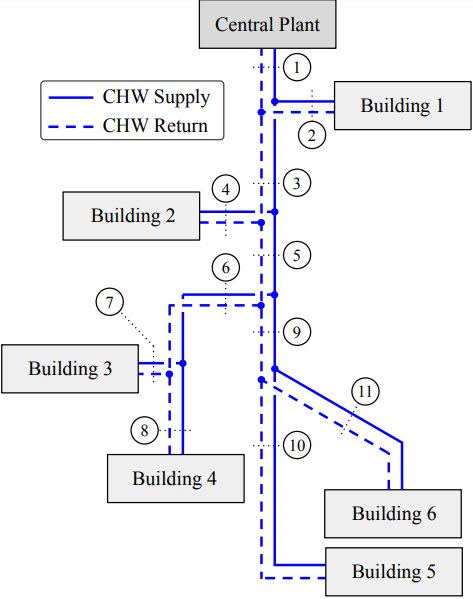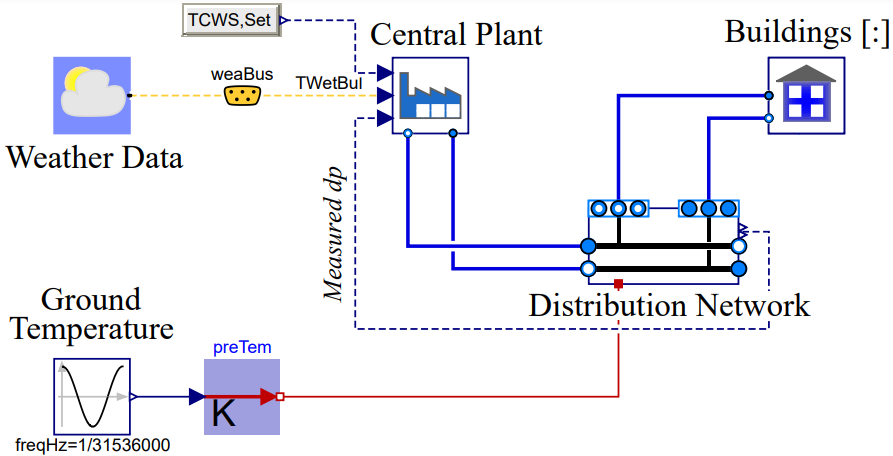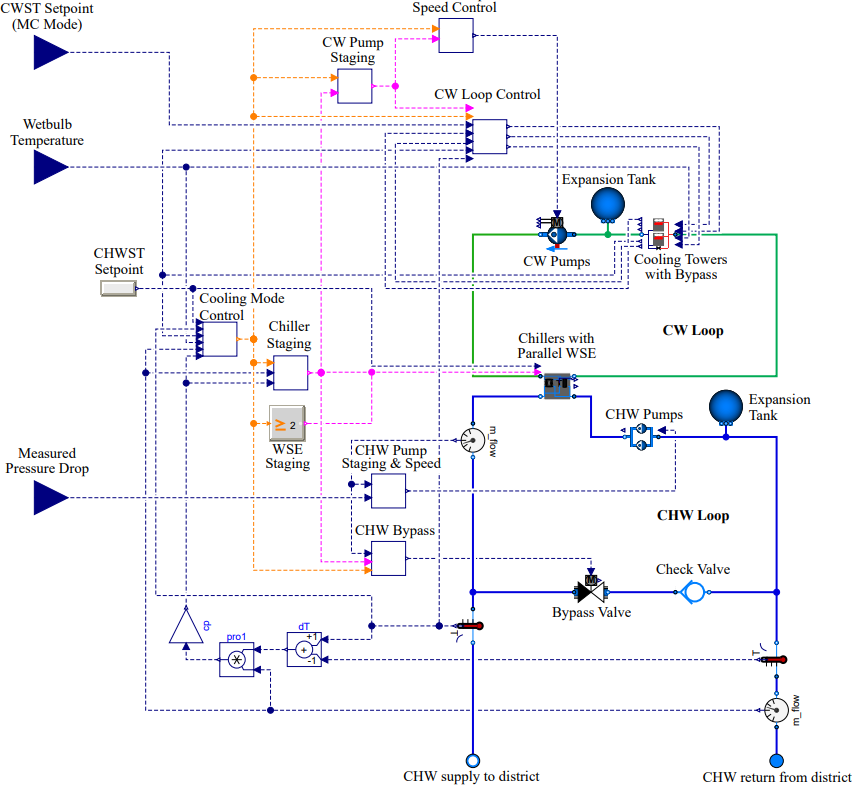District Cooling System Modeling: A Case Study with the University of Colorado Boulder
While equation-based object-oriented modeling language Modelica can evaluate practical energy improvements for district cooling systems, few have adopted Modelica for this type of large-scale thermo-fluid system. Further, to our best knowledge, district cooling modeling studies have yet to include hydraulics in piping networks alongside plant models featuring realistic mechanical systems and controls. These are critical details to include when looking to make energy and control improvements in many physical system installations. To fill these gaps, this study released new open-source district cooling models at the Modelica Buildings Library and leveraged these models for a real-world case study at the University of Colorado Boulder. The site includes six buildings connected to a central chiller plant featuring a waterside economizer. Several energy saving strategies are pursued based on the validated model, including control setpoint optimization, equipment modification, and pump setpoint adjustments. Results indicate that a combination of the studied measures can save the campus annually 84.6 MWh of energy, 8.9% of electricity costs, 58.0 metric tons of carbon dioxide emissions, while the waterside economizer cuts down chillers’ run times by 201 days/year, reducing maintenance costs and extending chiller life.

Fig.1 - Network topology for the district cooling system with pipe segments labels detailed in [1]

Fig.2 - Top-level diagram of the Modelica model for the district cooling system

Fig.3 - Schematic diagram of the central plant

Fig.3 - Diagram of the Modelica model for the district cooling plant




Factsheet
| Number of buildings | 6 buildings, 1 central plant |
| Number of thermal zones (per building) | 1 lumped time series model based on measured cooling load |
| Complexity of thermal zone model | Low order buildings, high order plant |
| Coupling/Decoupling between district network and buildings | Decoupling |
| Simulation tool | Dymola |
| Modelica libraries | Buildings |
| Additional packages/workflows/scripts | BuildingsPy – continuous integration testing |
| Simulation time | One year |
| Computational time | 20 minutes |
| Solver and tolerance | CVODE 1e-6 |
| CPU speed | Linux operating system, 32 GB RAM, 3.60 GHz Intel Xeon CPU |
Authors:
Kathryn Hinkelman (Pennsylvania State University - USA)
Jing Wang (National Renewable Energy Laboratory - USA)
Wangda Zuo (Pennsylvania State University - USA)
Antoine Gautier (Lawrence Berkeley National Laboratory - USA)
Michael Wetter (Lawrence Berkeley National Laboratory - USA)
Chengliang Fan (Guangzhou University - China)
Nicholas Long (National Renewable Energy Laboratory - USA)
Kathryn Hinkelman (Pennsylvania State University - USA)
Jing Wang (National Renewable Energy Laboratory - USA)
Wangda Zuo (Pennsylvania State University - USA)
Antoine Gautier (Lawrence Berkeley National Laboratory - USA)
Michael Wetter (Lawrence Berkeley National Laboratory - USA)
Chengliang Fan (Guangzhou University - China)
Nicholas Long (National Renewable Energy Laboratory - USA)
References:
[1] K. Hinkelman, J. Wang, W. Zuo, A. Gautier, M. Wetter, C. Fan, N. Long. 2022. "Modelica-Based Modeling and Simulation of District Cooling Systems: A Case Study." Applied Energy, 311, pp. 118654, 10.1016/j.apenergy.2022.118654.
[2] K. Hinkelman, J. Wang, C. Fan, W. Zuo, A. Gautier, M. Wetter, N. Long. 2021. "A Case Study on Condenser Water Supply Temperature Optimization with a District Cooling Plant." The 14th International Modelica Conference, Linköping, Sweden, pp. 587-595, 10.3384/ecp21181587.
[1] K. Hinkelman, J. Wang, W. Zuo, A. Gautier, M. Wetter, C. Fan, N. Long. 2022. "Modelica-Based Modeling and Simulation of District Cooling Systems: A Case Study." Applied Energy, 311, pp. 118654, 10.1016/j.apenergy.2022.118654.
[2] K. Hinkelman, J. Wang, C. Fan, W. Zuo, A. Gautier, M. Wetter, N. Long. 2021. "A Case Study on Condenser Water Supply Temperature Optimization with a District Cooling Plant." The 14th International Modelica Conference, Linköping, Sweden, pp. 587-595, 10.3384/ecp21181587.
